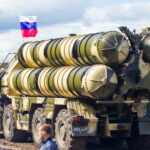You’re receiving this video a week after its initial posting on Patreon. If you’d like to get access to this content as soon as it’s released, along with a number of other exclusive perks, click the link below.
Our focus turns toward China today, specifically at the technological struggles facing the Chinese military and manufacturing industry. And yes, we’re starting with the nuclear submarine that sank in port…
The Chinese have been looking to make some upgrades to their technological capabilities across the board, but they’re not gaining much traction. As evidenced by the nuclear submarine that sank near Wuhan, China’s nuclear deterrent system is one area that could use some love. Unlike the US nuclear triad that provides redundancy and security, the Chinese really only have ICBMs to bail them out of nuclear troubles.
While the sinking of that sub is embarrassing, it’s far from the only area that the Chinese could use some help in. China is a manufacturing hub for low-tech stuff, including less advanced semiconductors. However, China has struggled to make much (if any) progress on the chip front, because they lack the expertise and access to operate the necessary machinery.
And things aren’t likely to improve anytime soon. US-China trade tensions are on the rise, and the coming US election isn’t likely to change that…regardless of who wins. With sanctions, tariffs and technological controls limiting China’s capabilities, it will be difficult for them to achieve technological parity with the US.
Here at Zeihan On Geopolitics we select a single charity to sponsor. We have two criteria:
First, we look across the world and use our skill sets to identify where the needs are most acute. Second, we look for an institution with preexisting networks for both materials gathering and aid distribution. That way we know every cent of our donation is not simply going directly to where help is needed most, but our donations serve as a force multiplier for a system already in existence. Then we give what we can.
Today, our chosen charity is a group called Medshare, which provides emergency medical services to communities in need, with a very heavy emphasis on locations facing acute crises. Medshare operates right in the thick of it. Until future notice, every cent we earn from every book we sell in every format through every retailer is going to Medshare’s Ukraine fund.
And then there’s you.
Our newsletters and videologues are free and we will never share your contact information with anyone. All we ask is that if you find one of our releases in any way useful, that you make a donation to Medshare. Over one third of Ukraine’s pre-war population has either been forced from their homes, kidnapped and shipped to Russia, or is trying to survive in occupied lands. This is our way to help who we can. Please, join us.
Transcript
Hey, everybody. Peter Zeihan here, coming to you from Salt Creek Beach, just outside of L.A., in California. Today, we’re going to talk about beacon policy, technology, China, and the U.S. elections. Yeah, that’s going to get me in trouble pretty much everywhere.
Okay, so the new news that leaked out over the last few days is that back sometime in the spring, the Chinese new nuclear attack submarine sank at a dock via Wuhan. It was a first-in-class ship, and first-in-class ships are notoriously buggy, but they usually don’t just, you know, sink. They had to fish it out of the river with a bunch of floating cranes.
Now, I don’t want to suggest that submarine engineering is easy, especially nuclear submarine engineering, but I gotta say, like, the definition of a submarine is something that doesn’t sink unless there’s a torpedo in it. So getting the basics wrong on this sort of thing is beyond embarrassing. And if you can kind of put this in context, imagine if in San Diego, a nuclear-powered vessel sank in harbor and the government tried to hide it from everyone. That’s basically what’s gone down here.
So, very, very sloppy engineering work, a sloppy propaganda campaign. But from a strategic point of view, I think it’s really important to understand what the Chinese do and do not have when it comes to nuclear deterrence. They have silos—ICBMs that would launch mostly from western China. They don’t have a functional sub arc, and they certainly don’t have a bomber arc.
So we’re talking about one type of deterrence, not the three that the United States has for redundancy. Now, whether that’s good, bad, or indifferent depends on what you care about, but the whole reason the United States maintains the triad is so that no matter what flavor of attack hits the United States, it always has at least one, probably two, backup plans. That sort of deterrence means countries aren’t going to nuke the United States, even before you consider things like missile defense. China is nowhere close to that, not in number of warheads, and certainly not in delivery methods.
This brings us to the general topological issues that the Chinese are trying to crack here. China has a lot of ambitions, and they say they’re planning on going into this, that, or the other thing. But desire is not the same as performance. So, consider, for example, semiconductors. The Chinese have something called deep ultraviolet technology that they’re pretty decent at, and chips that are in the 80-90 nanometer range or dumber, they can make themselves. But when the chips get more advanced—and that’s like what you put into most automotives, for example—they need not just foreign equipment, but foreign staff and foreign software.
Most of the chips being made today—things that are, as a rule, 20 nanometers and smaller—don’t use that technology unless you want to be wildly inefficient with it. Instead, they use something called extreme ultraviolet lithography, which is a technology basically completely controlled by the Dutch company ASML. Even if the Chinese were able to get their hands on some of those more advanced machines, it’s not like they could operate them. There are staffing issues, experience issues, and software issues. Plus, the Dutch have built their machines with remote kill switches, so they have to be involved in the process.
I don’t mean to say this to insult the Chinese. I mean to say this to insult everyone. No country controls enough of the semiconductor supply chain for anything that’s mid- or high-tier chips to do it themselves. You’re talking about a constellation of thousands of companies and dozens of countries, and it really does take a village. So, the Chinese desire to do all of this in-house? It’s just not going to happen, or at least not without a significant shift in how this technology works. It’s more likely to get more complicated in the future rather than less, which means we pretty much know what’s going to happen with U.S. politics and trade relations, because the parameters of what can and cannot be done with the technology are already known.
So, regardless of who wins the American presidential election—and we all have our own ideas on that—we’re looking at a situation where, on the Trump side, we know that tariffs are the plan. But the Biden administration has never repealed any of the tariffs that Trump put into place. On the Harris side of the equation, we know that technological controls are the preferred tool. But I can’t imagine a President Trump ever repealing those.
So, we’re looking at a tightening technological noose as the United States does something that China just can’t call on other countries for. Because, even at the depths of the Trump administration, when relations with allies were at their lowest, you still had countries that needed the United States for this, that, or the other thing. And so the United States was able to do technological sanctions on things like lithography that basically stalled the entire Chinese technological push.
They were able to use older technology like that deep ultraviolet I mentioned in order to brute force through some relatively low-quality chips that hit a couple of technological markers but were huge energy hogs, took up a lot more space, and generated a lot more heat. Not the kind of thing you’re going to use to reset the technological tables, especially when you start talking about some of the newer things ASML is trying to work on, like high numerical aperture, getting down to a one-nanometer chip. The Chinese don’t even have a finger in that world yet.
It takes everyone, played out across the economy, and there’s only so much the Chinese can do. They just don’t do the high-end stuff at all. They do the low end; they do the assembly. And that’s a multi-trillion-dollar operation—that’s not something to be scoffed at. But that’s not the same thing as parity, nuclear or otherwise.







